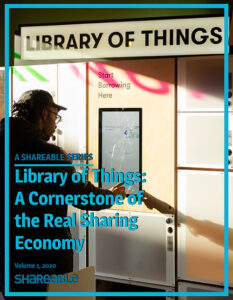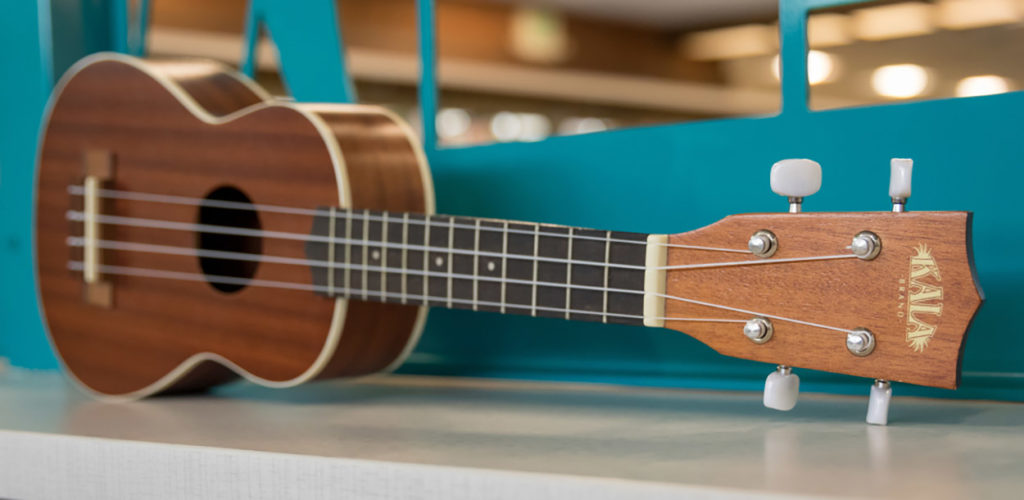If you’re working as a librarian and would like to expand your library’s collection to include physical objects, there are many resources out there to help you start a Library of Things. Libraries of Things lend predominantly expensive household items to people who otherwise could not afford them or would underuse them, but require a robust logistical framework — something libraries have already. That is why some pioneers of the Libraries of Things movement are setting up within the infrastructure already established by book-lending libraries, and librarians have a crucial role to play within this facet of the LoT movement.
The Sacramento Public Library has built up one of the largest and most respected Libraries of Things in the nation. At two locations and expanding into a third, its Library of Things catalog lists 120 items including handheld metal detectors, an air compressor, projectors, button-making machines, games, musical equipment, digital cameras, pressure washers, sewing machines, telescopes and even a post hole digger.
Across the country in Illinois, the Kankakee Public Library has just started a Library of Things with 17 items – including a ukulele. One challenge they face is that organizers don’t currently have a place to display the items, so they rely on a binder to advertise the library’s existence.
What does it really take to start a Library of Things within an existing library? While every librarian or community member might have a different perspective, it is important to identify community needs and obtain objects that will serve those needs. Libraries must be open to feedback and adapt to member needs. Passion is important but so are logistics – that’s why building a Library of Things within the strong infrastructure of a public library can lead to a very successful LoT.
Five steps to start a library of things within a library
1. Gather a multidisciplinary team and build resources
When first developing a library-based Library of Things, it’s important to have clear goals. “We thought the idea of the Library of Things would [be] fun, useful, and helpful. One one hand we thought of purchasing items that you use only once a year and therefore don’t need to invest money into. Instead of going to the store or borrowing from a neighbor you can come straight to our library. On the other had we also thought it would be a great way to try a product before purchasing it,” says Vicky Forquer of the Kankakee Public Library in Illinois. Once you have clear goals, it’s important to gather a team that can support the achievement of those goals.
While the idea for a Library of Things might come from one librarian, no one should embark on this endeavor without a support system. Think about what you might need to get the project off the ground, like legal advice and a marketing plan, and clearly define roles for each member. These roles might already exist within the library, but tackling a new project will require renewed commitment from all involved.
Next, seek out the resources you will need to get off the ground, remembering that you don’t have to start from scratch. Share Starter has published documents with advice on everything from bylaw wording to marketing strategies. Learn from pioneers like Gene Homicki, the cofounder and CEO of MyTurn, a software program used by over 400 Libraries of Things to catalog and organize their items.
While a committed team is essential, make sure that the program is bigger than any one person. If a program leader quits, will the Library of Things be thrown into a tailspin? More than one Library of Things has fallen apart following the sudden departure of a core team member. Distribute tasks and set up a system of checks and balances to ensure that power is decentralized.
2. Develop a budget
Even within an existing library system, the Library of Things still depends on funding, so develop a clear and realistic budget. How much should be invested in the project at the beginning? Set up a realistic and sustainable system for fees, returns, and fines to make sure that items are returned on time and in good condition. Many public library-based LoTs are totally free, but others may charge a small fee to use big-ticket items like lawnmowers or expensive power tools. It may be possible to tap into the library’s existing budget to fund a new Library of Things or leverage its nonprofit or government status to apply for grants. Molly Milazzo, Youth Services Librarian at the Sacramento Public Library’s Arcade Branch, says their Library of Things began as a grant-funded initiative but has since been absorbed into the library’s general budget.
Along with a budget, don’t forget about insurance. Public libraries may need to get an additional rider on their insurance policy when starting a Library of Things, but they may also be fully covered under their municipality. Either way, read the small print before stocking potentially dangerous items like chainsaws.
3. Do market research in your community.
Every community is different, so no two Libraries of Things are exactly alike. To ensure that your LoT fulfills a purpose, librarians must be attuned to the needs of the community—both immediate and long-term. Vicky Forquer of the Kankakee Public Library in Illinois said geography was a factor: “I would suggest starting small. Also, what works for one library won’t work for another. For example, we heard of a library checking out fishing poles. We didn’t think this would be popular in our community.” Fishing poles may not be popular in Kankakee but in Mesa, Arizona, a hiking kit or telescope (both available at the Stuffbrary) might fly off the shelves. In an urban food desert, gardening equipment could fill a need, while board games would be a welcome addition to a community with many young families.
Milazzo encourages librarians to “reach out to individual community members and local organizations for feedback; some of their suggestions may surprise you and will make for a richer collection.” Once you’ve identified community needs, consider posting a wish list if you are soliciting donated items. Doing basic local market research will ensure that the Library of Things makes an impact.
4. Plan storage and organization.
Many physical objects at LoTs can be bulky, which creates the challenge of how to store and display the items. Milazzo says, “Think as deeply as possible about the possibility of expansion (adding new items to the collection), maintenance, and storage of the collection. How large or small of a collection can your site conceivably support?” Storage is one challenge that the Kankakee Public Library system is facing right now. Forquer says, “As of right now, we don’t have a display case to show the items. We have a binder with all the items, which works for now but we want the items to shine!”

You also need to catalog the items and set up a system for lending them. Some libraries have incorporated the items into their existing catalog systems, while others use MyTurn, including the Sacramento library. One advantage of donated items is that the entire community often feels a sense of ownership and responsibility regarding the items, making it more likely that the items are returned on time and in good condition.
5. Keep an open mind.
Starting and running a library-based Library of Things is not without its challenges, which is why it requires an open mind. Learning about the objects is a significant aspect of ensuring that the community benefits from them but it can be time-consuming. If librarians embrace it as part of their daily life, the community will benefit. The librarians who oversee the Sacramento Public Library’s Library of Things have taken a hands-on approach from day one. They polled the community and, once the items were acquired, they used them themselves to make sure they knew how to show members how to use them. Milazzo said that having staff handle the items themselves — taking a GoPro on vacation, using a sewing machine, and testing a hedge trimmer and leaf blower — helped them anticipate potential complications and buy additional supplies like needles and thread.” As with any area of the library, such experimentation has allowed us to speak with greater authority about this collection and the different ways our patrons can use it.”
Sometimes change means downsizing or expansion. The Sacramento Public Library is considering expanding its Library of Things to South Sacramento. Milazzo explains, “We’re considering both the individual needs of South Sacramento communities and using data accumulated from the Library of Things on the most/least popular items, as well as which items require more attention than others (i.e. a lot of accessories that we’ve had to keep track of). Ultimately, this will likely manifest in an online poll and in-person feedback from patrons, since those methods have served us well in the past.”
When libraries decide to start a Library of Things, they leverage their reputation as a well-known, trusted community resource to meet a community need. With a clear plan, flexibility, and a dedication to patrons, Libraries of Things have the potential to change members’ lives for the better.
##
 |
This post is part of our 2020 editorial series on libraries of things. Download the free ebook from the series here. |









